
Aketh - Aketh - (becoming light)




Salt Contemporary In partnership with Everywhen Art & Artists of Ampilatwatja
February 6 - March 2, 2025




ALEC PULA LEWIS
DENISE NGWARRAYE BONNEY
ELIZABETH NGWARRAYE BONNEY
HEATHER PITJARA CORBETT
JACINTA PULA MORRISON
JESSIE NGWARRAYE ROSS
JULIEANNE NGWARRAYE MORTON
KATHLEEN NANIMA RAMBLER
KINDY KEMARRE ROSS
MAISIE PETYARRE BUNDEY
MICHELLE PULA HOLMES
NANCY PITJARA FRANK
RITA PITJARA BEASLEY
SELINA PULA TEECE
SEVANIA KEMARRE BONNEY

Aketh-Aketh (becoming light) features new works by 15 Alyawarr artists of the Ampilatwatja community, approximately 300km northeast of Alice Springs. Since the artists established their art centre in 1999, Artists of Ampilatwatja has carved out a unique place in contemporary Australian First Nations art.
Rather than depicting the iconography of dreaming stories - as in the paintings of western and much other central desert art - Ampilatwatja painters reinforce their strong connection to Country in landscape form and with a strong focus on the plants used for bush medicine.
As they describe it, their paintings depict the country ‘on which the dreaming stories sit’. However, these intricate paintings are far from superficial view of lands. Rather they contain the information held sacred to Alyawarr, but hidden from public view, underneath the surface. Artists have talked of two broad levels of interpretation, the “inside” stories which are restricted to those of the appropriate ritual standing, and the “outside” stories which are open to all.
The paintings also help us, the viewers, to understand that what we may imagine to be harsh and featureless deserts are in fact anything but. Here intersecting the red-earthed lands are watercourses snaking their way through lightly forested terrain. After the rains, the country bursts into life in numerous shades of green, punctuated by magenta, yellow, purple, white, orange and red wildflowers.
In this uplifting exhibition, 15 artists have responded to the theme of “aketh-aketh” - the soft light of dawn as it breaks over Alyawarr lands. In early mornings, and again at dusk, the outback gains a particular quality of stillness as the long rays of the sun wash the earth in soft pink, purple and golden light.
Artists including Elizabeth Ngwarreye Bonney (who is also a senior traditional healer), her husband Alec Pula Lewis, Denise Ngwarreye Bonney, Heather Pitjara Corbett, Jacinta Pula Morrison, Kathleen Namina Rambler and Selena Teece Pwerle take a broad view of the lands of their forebears.
Landscapes are depicted in meticulous detail by Alec Pula Lewis, Denise Ngwarreye Bonney, Heather Pitjara Corbett and Kathleen Namina Rambler, while Selena Teece Pwerle and especially Elizabeth Ngwarreye Bonney depict their lands in more painterly style.
Paintings that feature the plants themselves include soft-hued works by senior artists Jessie Ngwarreye Ross, Kindy Kemarre Ross, Nancy Pitjara Frank, Rita Beasley and younger artist Sevania Kemarre Bonney while stronger colours are seen in the works of award-winning artist Michelle Pula Holmes, Rita Beasley and Julianne Morton. Striking is a small lyrical abstract by Maisie Petyarre Bundey.
The glowing paintings in this exhibition both delight and excite as they simultaneously demonstrate the painters’ strong connection to, and care of their lands.
Susan McCulloch OAM, January 2024


Knowing one’s country is an important part of living in a remote community like Ampilatwatja. Knowing when and where to go hunting and gathering, knowing where there is ‘soakage’ (where you can dig for water), travelling with family for ceremonies, and maintaining a connection with the land. Alec says that this painting is his country “my view of country”.
Alec was born at McDonald Downs Station. He grew up there with his family living traditionally on the land. Alec did not attend school, he moved between different communities with his family.
Alec lives in Ampilatwatja with his wife Elizabeth Ngwarraye Bonney, who is also a painter. To ensure continuation of culture Alec passes his knowledge of the land to his children and family. Alec paints his mother’s country, Amaroo Station.


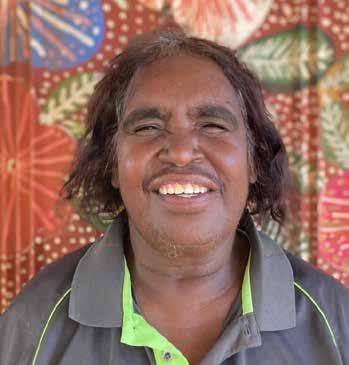
Denise paints ‘Tijamburra’, her Grandmother’s country.
“This is my Mothers Mothers country, out near Canteen Creek, we go hunting for wild onions, goannas, echidnas and sugar bag honey in the trees. I like to hunt in my country, there is water all year round even if it look dry, we follow the bird tracks to know where to dig and then we find water.This painting is after rain, many grasses are out, but the riverbed is still sandy”.
Denise was born in 1968 and is a well-known artist painting with the Eastern Desert community of Ampilatwajta, She has been painting since 2007 and enjoys painting on her own and with her daughters and mother Eileen Bonney - a senior member of Artists of Ampilatwatja.
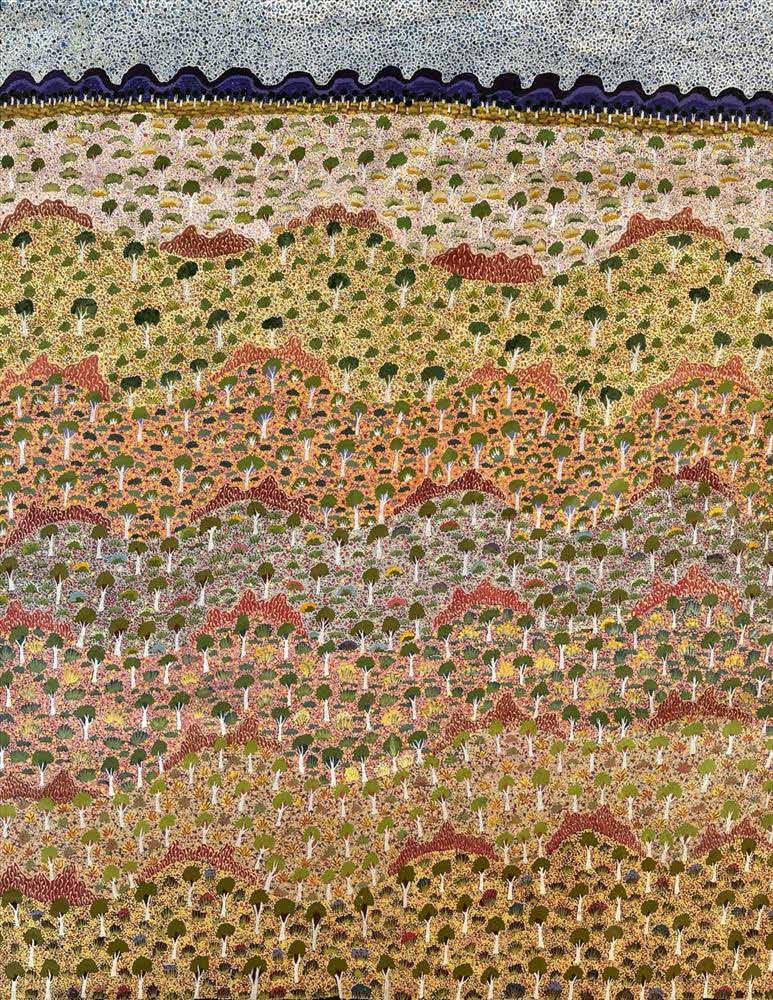

“I still hunt my Grand Mothers country for goanna, bush medicine and yams. I hunt all year round, hunting and walking through the country makes me happy. When I look at the distant hills I can feel my grandmother. Bush flowers are everywhere. Painting my grandmother’s country reminds about those times.”
“My Great Great Grandfather’s country is Arlenkw. My Grandfather’s Mother’s country is Titjambera. My Great Grandmother’s country is Arene. I paint to keep my country alive, so we can know and teach our young ones, our grandchildren. When I’m not painting I like to go visiting family or hunting for echidna, sugar bag and bush potato”.
Elizabeth was born in Tennant Creek. Her mother Eileen is one of the original artists of Ampilatwatja and for many years they would sit and paint together. Elizabeth is one of the senior traditional healers in Ampilatwatja.


“I like going hunting for bush tucker and bush medicine flowers. I like to see the different landscapes of this country and watch the seasons change. The landscape reminds me of my parents and my grandparents. This is where they would hunt too.”
The community of Ampilatwatja made a conscious decision not to paint ‘altyerr’ dreaming stories, the artists paint their country where those stories sit. This painting shows the layered landscape of Alyawarr, Central Australia.
Knowing your country is an important part of living in a remote community like Ampilatwatja. Knowing when and where to go hunting and gathering, knowing where there is ‘soakage’ (where you can dig for water), travelling with family for ceremonies, and maintaining a connection with the land.”
Heather has been painting with Artists of Ampilatwatja only for the past couple of years. Her artworks have been sent to a number of galleries around Australia. She uses bright colours and mixes fine dot work with sometimes naïve presentations of country, the result is a vibrant artwork that communicates her love for her country and the simplicity of living on it.


This painting shows the layered landscape of Alyawarr, Central Australia. Knowing your country is an important part of living in a remote community like Ampilatwatja. Knowing when and where to go hunting and gathering, knowing where there is ‘soakage’ (where you can dig for water), travelling with family for ceremonies, and maintaining a connection with the land.
“This is my country, my view of country.”
Morrison is an emerging artist who paints the layered landscape of Alyawarr, Central Australia. Knowing your country is an important part of living in a remote community like Ampilatwatja.

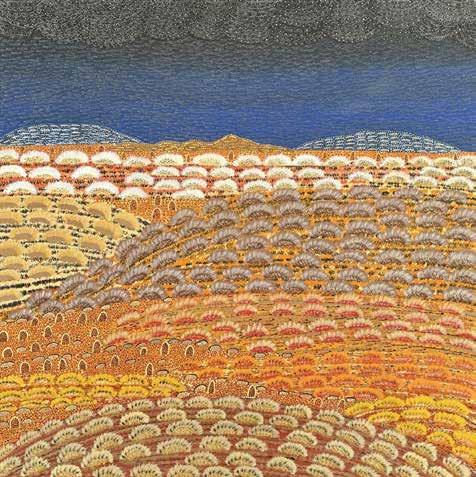

Jessie’s landscapes beautifully communicate the rich knowledge she possesses of medicinal plants and country, the heart of her culture. Jessie has painted her country, Ampilatwatja. The brightly coloured flowers and small bushes are bush medicine and are still used within the community.
Jessie’s predominant theme in her paintings is ‘strong bush medicine’, demonstrating a deep connection to her Country. Her work pays homage to the significance and use of traditional bush medicine, allowing an insight into her community.
Yet underneath the iridescent surface, there is an underlying sense that there is more to this landscape than meets the eye. In keeping with the religious laws, Jessie reveals only a small amount of knowledge to the uninitiated.


“My Mother, Lilly Kemarre, taught me to paint. She likes to paint her Mother’s and Father’s country from the old days, when they used to live off of the land.”
Julieanne’s paintings are inspired by her Mother’s stories of the old days, walking and living on their land, and also of her own experience of life out here in Alyawarr country.
“The landscape changes during the different seasons in the year. I paint the dried flowers and bushes from last season as well as the new plants that come after the rain. These plants have special meanings and uses for us. I have been taught how to read the country, and now I teach my children these skills.”
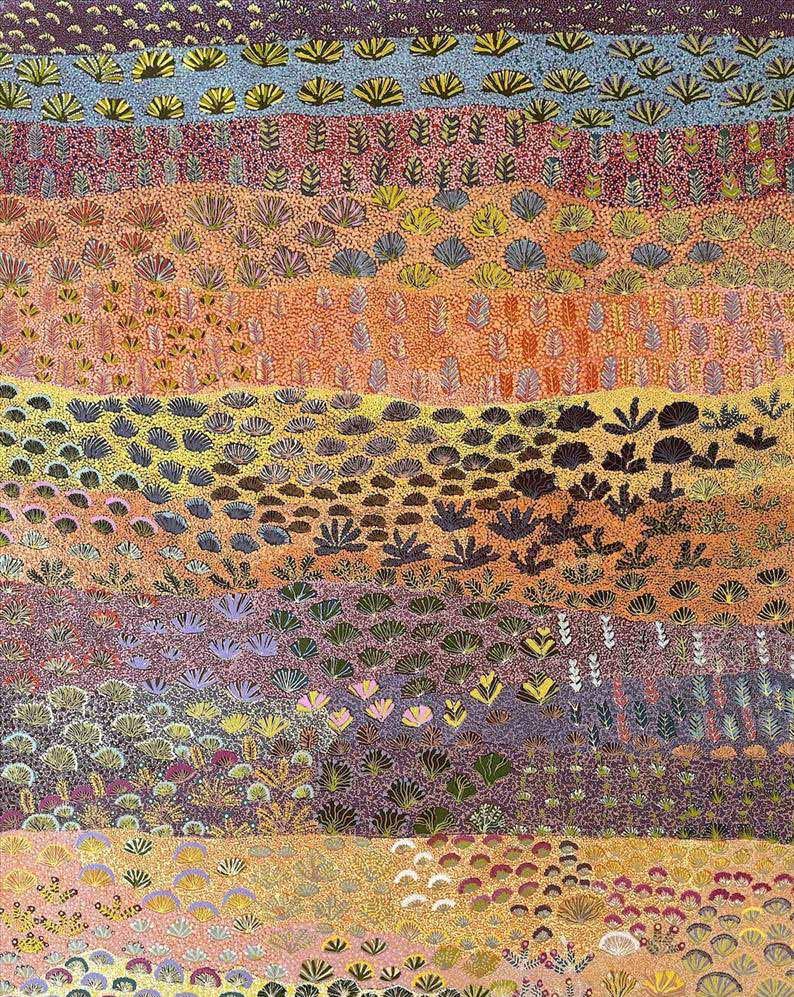

“I paint the country of my Father and Mother and where they grew up, near Barrow Creek”.
“This is the painting of my Father’s country, where I grew up. When we would go hunting, we always climbed those hills. We would take the kids hunting too and take photos of the hills. I use bright colours and beautiful detail and attention to detail expresses the love and joy that I have for the country closest to my heart”.
Kathleen’s dot work is exquisitely fine and she uses this technique to make patterns within the landscapes of her paintings demonstrating her peaceful, patient disposition and a deep love and connection to her country. The work produced by Kathleen is recognisably distinct, due to the application of her fine patterned dots and the often bright and lively figurative depiction of the landscape.
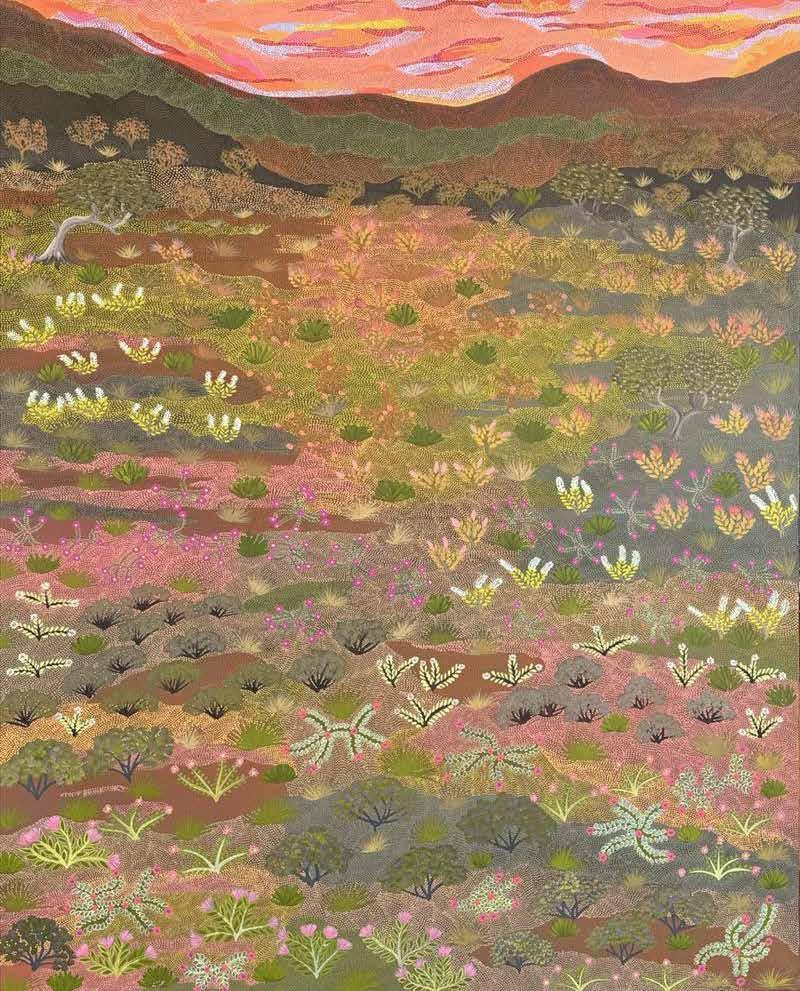

“My country is called Irrultja, it’s past the hill and the dried-up creek from here. It’s a nice place, my Dad’s country too, and my Mum’s country is here in Ampilatwatja. When I go to see my country, we always go to gather bush medicine, we always climb up the hill that’s in the south, we always go there. We like to look out over the land and there are lots of flowers and bush medicine up there.
I love my countryside; I see the nice flowers and gather bush medicine for me and my family. I like to paint a mix of wildflowers and bush medicines in all my paintings because it reminds me of my favourite part of my country and when it rains the flowers come out. Yeah, my countryside.”


Maisie paints the bush tucker found in her country, the area that surrounds Boundary Bore in the Utopia homelands. She paints bush plums, bush bananas, bush potatoes and bush medicine plants.
The main motif which recurs often in Maisie’s artworks is a full coolamon. When she paints she always speaks of gathering and hunting on her country; “Long way from here, long time ago”, filling up coolamons with “bush potato, bush banana, goanna and porcupine”. Maisie always says her family are “happy ones, healthy ones”.
Maisie was one of the original Batik painters of Utopia. Maisie and her sisters Bessie, Kate and Josie are prolific painters who learnt to paint by watching their mother Polly Ngale.
Growing up on Utopia Station, her family worked at the station. Her father was a stockman and worked with horses and cattle. She loved the life and growing up at the cattle station with her family.



“When I go out hunting I always like to see the colour in the trees, the light, the dark and the bush medicine plants growing on the sand hills. The colours change at sunrise and sunset. I like hunting and seeing my country.”
I love to paint since childhood. My paintings show my deep love for my country and the beauty I see.
Michelle’s subject matter is always ‘strong bush medicine’, demonstrating a deep connection to her country. Her work pays homage to the significance and use of traditional bush medicine, allowing an insight into her community.
Michelle’s family still traditionally hunt and gather, the love for her land, plants, flowers and trees inspire her paintings from season to season.


“I was born in the bush at Ammaroo Station, along the Sandover. I have never seen the ocean or a big city. My mother and father were strong healthy people who taught me and my younger sister Rita the traditional way to hunt for kangaroo, goanna and porcupine.
We know how to gather bush tucker (secrets of the earth) and bush medicine plants. My mother used grinding stones to make seed damper. When I paint I think about good memories, being a young girl and walking through the land.
My mother made paint from two stones and showed us ceremony painting and how to sing and dance for ceremonies. I still sing and dance and collect the bush medicines; I like to make tea from the small purple flowers of Arreth (hill fuchsia). Painting bush medicine stories is important because it helps to maintain a strong knowledge and culture for the community.”
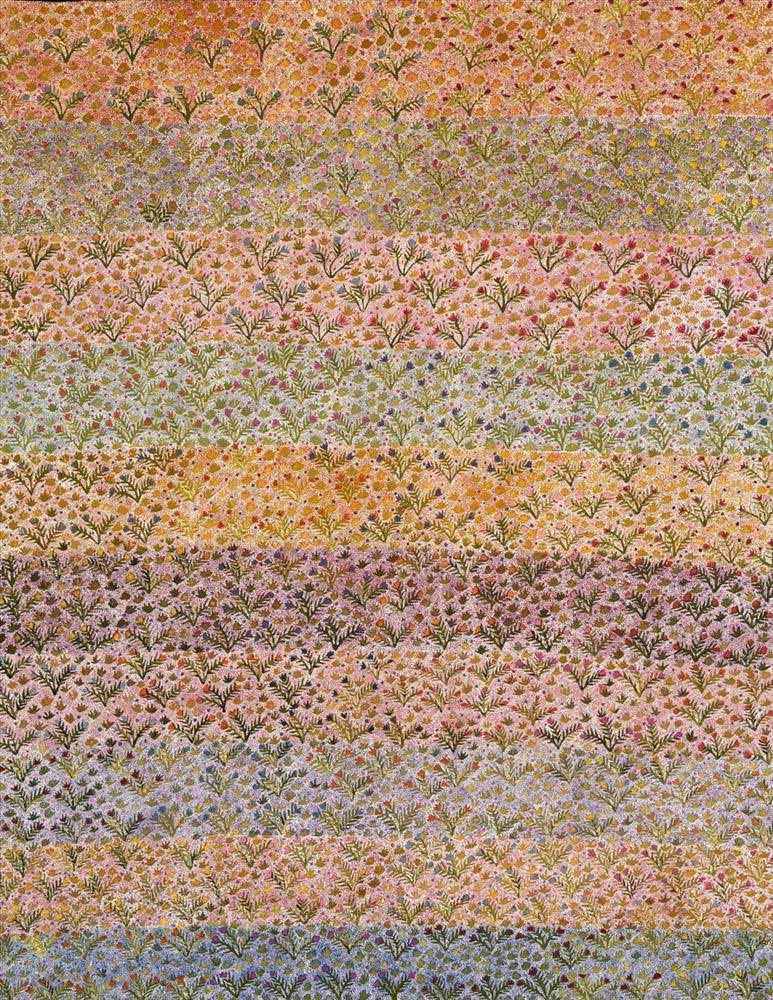

“This is my Father’s country. This place is our hunting place. I always go with my daughters and their children, I show them this place and teach them about the swampy country. We hunt for goannas, bush potato, bush tomato and after the big rain the bush medicine is picked and the roots are dug up to be used. It is important as my mother taught me this and now I teach my family.”
Rita Beasley is married to Murphy Teece, also an artist of the community, and lives at Ampilatwatja with their extended family. Rita has been painting for a period of some twenty years. She enjoys painting and feels it important for the community. Her artworks show special hunting and gathering grounds, all of which are connected to the dreaming of that country.
Rita’s vibrant palette, shifting patterns of pointillism, depiction of plant, geography and light, comes from Rita’s intimate affnity with her country.

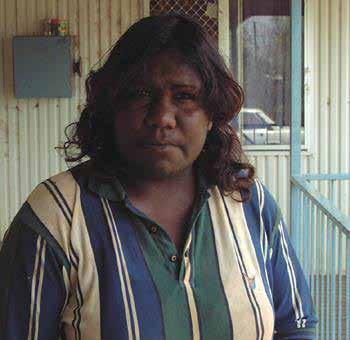
“This is my Father’s country. This country provides many bush foods for my people. Painting my country helps to keep the country very strong for current and future generations of Alyawarr people.”
Selina Teece Pwerle was born in 1977 in her traditional country of Antarrengeny, which lies in Alyawarr country north of the Utopia region in Central Australia. Selina grew up in the 1980s and 90s surrounded by famous artists of the Utopia school of painting and developed her own artistic talents at a very young age and is increasingly revealing a great versatility as an artist.
Her painting themes range from depictions of gum blossoms and the leaves of the spinifex plant to landscapes that relate the stories from her father’s country Antarrengeny. Notable for its fine sense of colour and balanced design, Selina is dedicated to furthering her artistic career and is proving to be one of the most exciting newer talents of the younger generation artists of the Eastern Desert school of painting.


“This is my country, my view of country.”
“I like to go hunting, watching landscape, pretty flowers after the rain”
Sevania was born in Soakage Bore, Utopia and started to paint when she was teenager. She learnt the way to paint landscape and bush medicine from her grandmother, Eileen Bonney, a former health worker and artist. Sevania finds painting soothing and enjoys to share this activity with her kids so they can learn as she did with her grandmother.

FEBRUARY 6 - MARCH 2, 2025
For all enquiries contact the gallery
Salt Contemporary
In partnership with Everywhen Art & Artists of Ampilatwatja
info@salt-art.com.au
+61 3 5258 3988
+61 439 353 624
salt-art.com.au
33-35 Hesse St, Queenscliff, VIC, 3225


